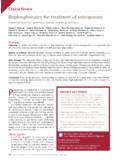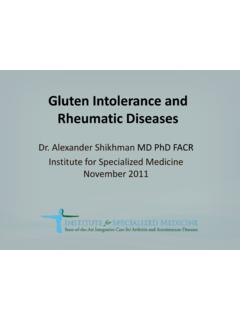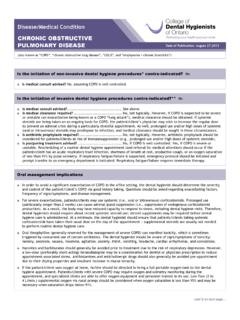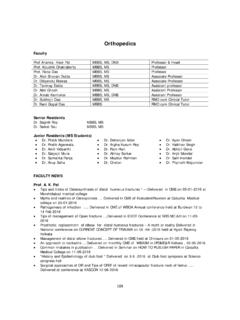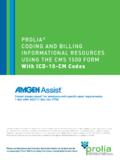Transcription of FOSAMAX - Medsafe
1 NEW ZEALAND DATA SHEET S-WPC-MK0217-MF-052015 1 Name of Medicine FOSAMAX alendronate sodium 5 mg, 40 mg & 70 mg tablets Presentation 5 mg: A round white tablet with an outline of a bone image on one side and MSD 925 on the other. The diameter is mm. (Not currently available in New Zealand.) 40 mg: A triangular white tablet with FOSAMAX engraved on one side and MSD212 on the other. The side length is mm x 8 mm. 70 mg: A white oval tablet with the outline of a bone image on one side and 31 on the other. Dimensions are mm x mm. Therapeutic Class Bisphosphonates are synthetic analogs of pyrophosphate that bind to the hydroxyapatite found in bone. FOSAMAX (alendronate sodium, MSD) is a bisphosphonate that acts as a potent, specific inhibitor of osteoclast-mediated bone resorption. Indications FOSAMAX is indicated: In postmenopausal women for the treatment of osteoporosis to prevent fractures, including those of the hip and spine (vertebral compression fractures).
2 In postmenopausal women who are at risk of developing osteoporosis FOSAMAX is indicated for the prevention of osteoporosis to reduce the risk of future fracture. For the treatment of osteoporosis in men to prevent fractures. For the treatment and prevention of glucocorticoid-induced osteoporosis in men, premenopausal women and postmenopausal women receiving oestrogen. For treatment of Paget s disease of bone in men and women. Dosage and Administration FOSAMAX must be taken at least one-half hour before the first food, beverage, or medication of the day with plain water only. Other beverages (including mineral water), food, and some medications are likely to reduce the absorption of FOSAMAX (see Interactions). To facilitate delivery to the stomach and thus reduce the potential for oesophageal irritation, FOSAMAX should only be swallowed upon arising for the day with a full glass of water and patients should not lie down for at least 30 minutes and until after their first food of the day.
3 FOSAMAX should not be taken at bedtime or before arising for the day. Failure to follow these instructions may increase the risk of oesophageal adverse experiences (see Warnings and Precautions). patients should receive supplemental calcium and vitamin D, if dietary calcium is inadequate (see Warnings and Precautions). NEW ZEALAND DATA SHEET S-WPC-MK0217-MF-052015 2 No dosage adjustment is necessary for the elderly or for patients with mild-to-moderate renal insufficiency (creatinine clearance 35 to 60 mL/min). FOSAMAX is not recommended for patients with more severe renal insufficiency (creatinine clearance < 35 mL/min) due to lack of experience. Treatment of Osteoporosis in Postmenopausal Women and in Men The recommended dosage is one 70 mg tablet once weekly. Prevention of Osteoporosis in Postmenopausal Women The recommended dosage is 5 mg once a day. Treatment and Prevention of Glucocorticoid-Induced Osteoporosis in Men, Premenopausal Women and Postmenopausal Women Receiving Oestrogen The recommended dosage is 5 mg once a day.
4 The optimal duration of use has not been determined. All patients on bisphosphonate therapy should have the need for continued therapy re-evaluated on a periodic basis (see Clinical Studies). Paget s Disease of Bone in men and women The recommended treatment regimen is 40 mg once a day for six months. Retreatment of Paget s Disease In clinical studies during the 12 months following therapy, relapses occurred in only 9% (3 out of 32) of patients who responded to treatment with FOSAMAX . Specific retreatment data are not available, although responses to FOSAMAX were similar in patients who had received prior bisphosphonate therapy and those who had not. Retreatment with FOSAMAX may be considered following a six month post-treatment evaluation period in patients who have relapsed based on increases in serum alkaline phosphatase. Retreatment may also be considered in those who failed to normalise their serum alkaline phosphatase. Contraindications Abnormalities of the oesophagus which delay oesophageal emptying such as stricture or achalasia.
5 Inability to stand or sit upright for at least 30 minutes. Hypersensitivity to any component of this product. Hypocalcaemia (see Warnings and Precautions). Warnings and Precautions FOSAMAX , like other bisphosphonates, may cause local irritation of the upper gastrointestinal mucosa. Oesophageal adverse experiences, such as oesophagitis, oesophageal ulcers and oesophageal erosions, rarely followed by oesophageal stricture or perforation have been reported in patients receiving treatment with FOSAMAX . In some cases these have been severe and required hospitalisation. Physicians should therefore be alert to any signs or symptoms signalling a possible oesophageal reaction and patients should be instructed to discontinue FOSAMAX and seek medical attention if they develop dysphagia, odynophagia, retrosternal pain or new or worsening heartburn. NEW ZEALAND DATA SHEET S-WPC-MK0217-MF-052015 3 The risk of severe oesophageal adverse experiences appears to be greater in patients who lie down after taking FOSAMAX and/or who fail to swallow it with a full glass of water, and/or who continue to take FOSAMAX after developing symptoms suggestive of oesophageal irritation.
6 Therefore, it is very important that the full dosing instructions are provided to, and understood by, the patient (see Dosage and Administration). While no increased risk was observed in extensive clinical trials, there have been rare (post-marketing) reports of gastric and duodenal ulcers, some severe and with complications. Because of possible irritant effects of FOSAMAX on the upper gastrointestinal mucosa and a potential for worsening of the underlying disease, caution should be used when FOSAMAX is given to patients with active upper gastrointestinal problems, such as dysphagia, oesophageal diseases (including known Barrett's oesophagus), gastritis, duodenitis, or ulcers. To facilitate delivery to the stomach and thus reduce the potential for oesophageal irritation patients should be instructed to swallow FOSAMAX with a full glass of water and not to lie down for at least 30 minutes and until after their first food of the day. patients should not chew or suck on the tablet because of a potential for oropharyngeal ulceration.
7 patients should be specifically instructed not to take FOSAMAX at bedtime or before arising for the day. patients should be informed that failure to follow these instructions may increase their risk of oesophageal problems. patients should be instructed that if they develop symptoms of oesophageal disease (such as difficulty or pain upon swallowing, retrosternal pain or new or worsening heartburn) they should stop taking FOSAMAX and consult their physician. Localised osteonecrosis of the jaw (ONJ), generally associated with tooth extraction and/or local infection (including osteomyelitis) with delayed healing, has been reported rarely with oral bisphosphonates (see Adverse Effects, Post-Marketing Experience). Most reported cases of bisphosphonate-associated ONJ have been in cancer patients treated with intravenous bisphosphonates. Known risk factors for ONJ include a diagnosis of cancer, concomitant therapies ( chemotherapy, radiotherapy, corticosteroids, angiogenesis inhibitors), poor oral hygiene, co-morbid disorders ( periodontal and/or other pre-existing dental disease, anaemia, coagulopathy, infection) and smoking.
8 patients who develop ONJ should receive appropriate care by an oral surgeon and discontinuation of bisphosphonate therapy should be considered based on individual benefit/risk assessment. Dental surgery may exacerbate the condition. For patients requiring invasive dental surgery ( tooth extraction, dental implants), clinical judgment of the treating physician and/or oral surgeon should guide the management plan, including bisphosphonate treatment, of each patient based on individual benefit/risk assessment. Bone, joint, and/or muscle pain has been reported in patients taking bisphosphonates. In post-marketing experience, these symptoms have rarely been severe and/or incapacitating (see Adverse Effects, Post-Marketing Experience). The time to onset of symptoms varied from one day to several months after starting treatment. Most patients had relief of symptoms after stopping treatment. A subset had recurrence of symptoms when rechallenged with the same medicine or another bisphosphonate.
9 NEW ZEALAND DATA SHEET S-WPC-MK0217-MF-052015 4 Low-energy fractures of the subtrochanteric and proximal femoral shaft have been reported in a small number of long-term (usually longer than three years) bisphosphonate-treated patients . Some were stress fractures (some of which were reported as insufficiency fractures) occurring in the absence of apparent trauma. Some patients experienced prodromal pain in the affected area, often associated with imaging features of stress fracture, weeks to months before a complete fracture occurred. Approximately one third of these fractures were bilateral; therefore the contralateral femur should be examined in patients who have sustained a femoral shaft stress fracture. Stress fractures with similar clinical features also have occurred in patients not treated with bisphosphonates. patients with suspected stress fractures should be evaluated, including evaluation for known causes and risk factors ( vitamin D deficiency, malabsorption, glucocorticoid use, previous stress fracture, lower extremity arthritis or fracture, extreme or increased exercise, diabetes mellitus, chronic alcohol abuse), and receive appropriate orthopaedic care.
10 Interruption of bisphosphonate therapy in patients with stress fractures should be considered, pending evaluation of the patient, based on individual benefit/risk assessment. patients should be instructed that if they miss a dose of FOSAMAX once weekly, they should take one tablet on the morning after they remember. They should not take two tablets on the same day but should return to taking one tablet once a week, as originally scheduled on their chosen day. FOSAMAX is not recommended for patients with creatinine clearance < 35 mL/min (see Dosage and Administration). Causes of osteoporosis other than oestrogen deficiency, ageing, and glucocorticoid use should be considered. Hypocalcaemia must be corrected before initiating therapy with FOSAMAX (see Contraindications). Other disorders affecting mineral metabolism (such as Vitamin D deficiency) should also be effectively treated. In patients with these conditions, serum calcium and symptoms of hypocalcaemia should be monitored during therapy with FOSAMAX .












